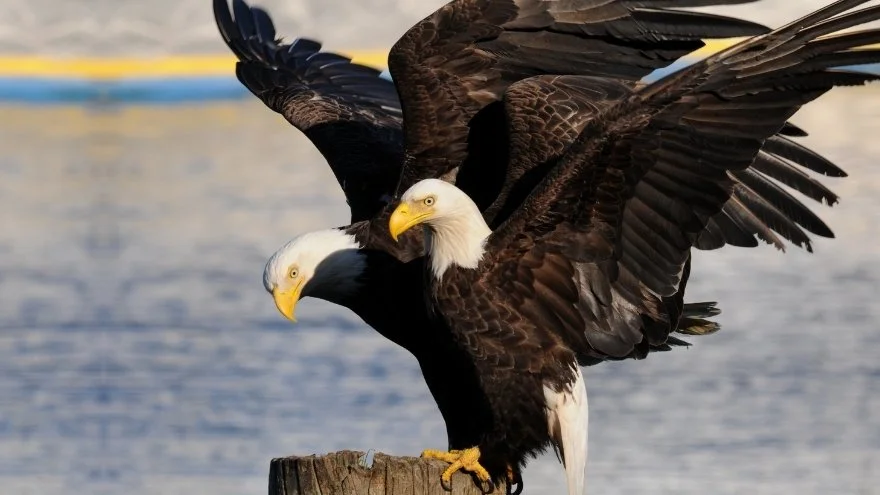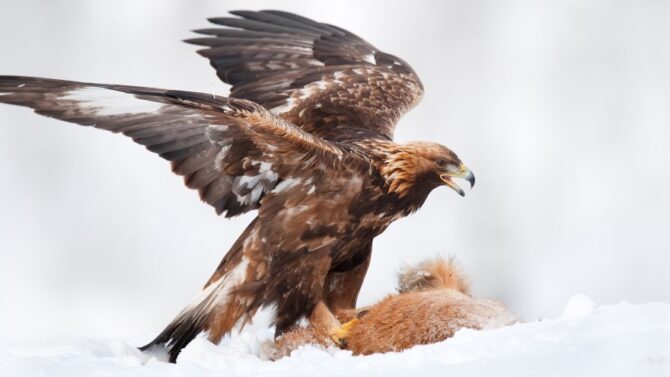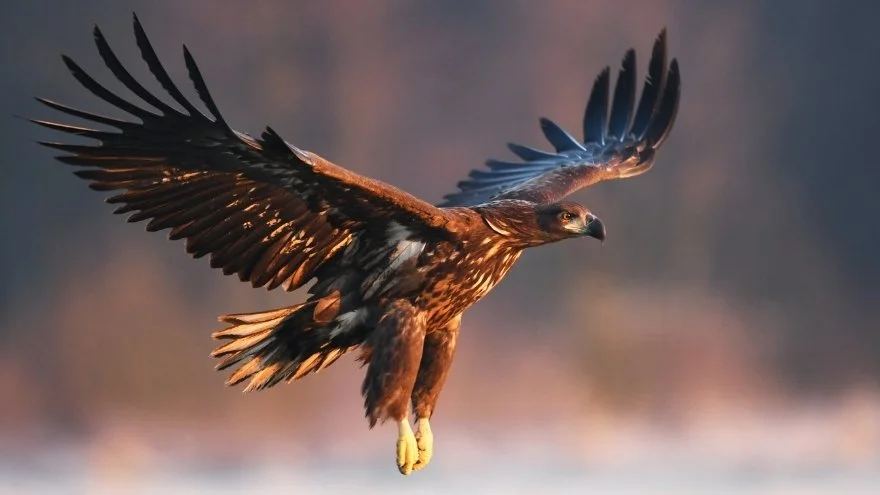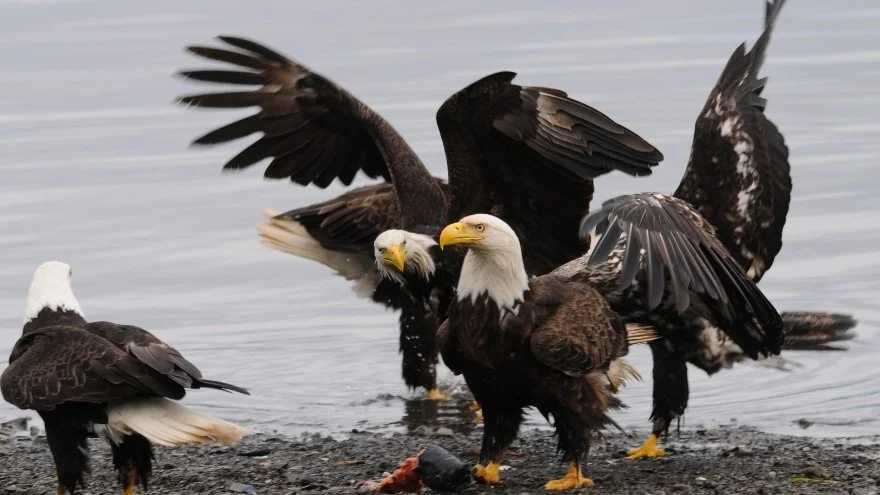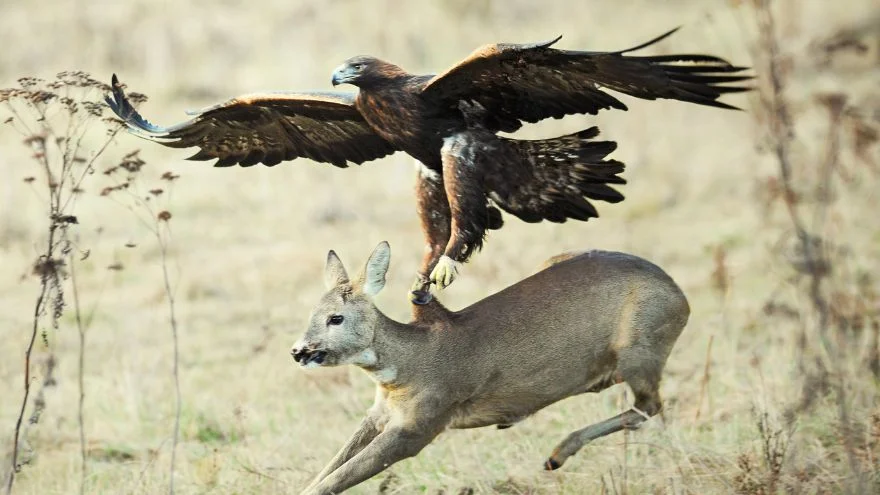From the age of sexual maturity till the end of their lives, eagles are capable of mating with the same partner.
Simple actions serve as courtship displays or renewal of bonding. These include the male picking rocks, dropping them, and catching them mid-air.
The female does likewise with some clumps of soil. The couple also perches together and creates a nest. There’s also the process of reproduction. But how do eagles mate?
To mate, the male flies gracefully and lands on the female’s back, using his wings to balance. He positions his cloaca under the female’s tail, and she positions hers too. Sperm passes from the male to the female’s cloaca into the oviduct for fertilization.
This article will provide insights into how eagles mate, with facts about the reproduction and life cycle of these birds.
How Do Eagles Mate?

Eagles generally reproduce through certain courtship behaviors such as circling the air, nesting, and mating where the male lands on the back of the female; both cloaca touch and sperm flow from the male to the female.
This is called the cloaca kiss. After a successful copulation, the female typically lays fertilized eggs after about 5 to 10 days.
The courtship between an eagle pair is primarily displayed through two methods:
The mating dance
Eagles set out to look for a mate when they mature sexually, usually around 4-5 years of age.
They perform magnificent aerial exhibitions during mating seasons, soaring high in the air and locking talons and cartwheeling towards the ground, releasing their locks and flying apart just before hitting the ground.
Eagles don’t copulate in mid-air, as most people assumed. Rather, they mate on a tree branch or the ground. Once a mate is selected, mating takes place for life.
Nesting
The male and the female eagle equally collect materials for building nests, although the female decides the outlook of the nest and designs the interior.
They interweave nest-building materials like twigs and sticks on top of the tree. Bald eagle nests are enormous, with their shapes determined by the branch supporting them.
Fun fact: St. Petersburg in Florida harbors is where the largest bald eagle’s nest was found. The nest was almost 305cm wide and 610cm tall and weighed more than 2000kg. 1
The average size of a bald eagle’s nest lies between 152.4 – 274.3cm in diameter, standing 61- 122cm tall. The eagle lines the nest with grass or moss to make it stable for holding eggs.
How Often Do Eagles Mate?
Eagles may mate throughout the year. Constant mating during the breeding season helps to facilitate bonding between the pair. 2
Mating also increases the chance of laying fertile eggs. A female is fertile during the breeding season for a 3 two weeks window period.
The increase in daylight savings makes the female secret a hormone that turns on the ova, and the male’s sperm is viable inside the female for 10 days.
It is common for the female to lay a clutch of two eggs, although she can lay up to four. For about 40 days, she incubates the eggs by sitting on them to keep them warm.
Incubation typically ranges from 30 – 50 days. Also, the male can incubate the egg, but hunting small mammals and feeding the female is common.
Do Eagles Mate With One Partner For Life?
Eagles are monogamous and typically mate with the same partners for life.
However, when they lose their partner, they take up new partners and start a new bond within the same territory. This replacement can occur even within hours.
Also, an intruding adult could fight a resident bird for a territory. Therefore, a pair is expected to migrate together, return to their nest, mate, and hatch their young.
If a deviation from this is detected, a partner has likely been replaced.
Females often make the choice of a partner. When she’s ready to select, she prepares well for many males who would come for display.
She does the scrutiny. If the flight display of one male impresses her, she picks a stick and flies high with it.
Do Eagles Mate in the Air?
Male and female eagles have been observed to soar high in the air, locking their talons and cartwheeling downwards before letting go; occasionally, just eye blinking moments before hitting the ground.
Courtship displays happen in mid-air. However, this doesn’t mean that eagles mate mid-air.
Eagles mate while perched on trees, with cloacae touching and sperm transferred from the male to the female.
What is the Eagle’s Lifecycle?

When you look at those fuzzy puffs cuddled up in their nest, it is hard to believe that they will quickly grow and attain the form of their majestic parents.
When an eagle egg hatches, a small cotton-like ball of fluff slowly comes forth. This adorable fuzzy creature depends on its doting parents for survival.
However, with time, the white fluff transforms into brown feathers, and the bird tests its wings, soaring high and developing till it eventually becomes a splitting image of its parents.
Here’s how this tiny creature materializes into a majestic eagle.
1. Hatchlings
After the egg has cracked, it can take a while for the eaglet to emerge, called pipping. The order in which the female eagle lays eggs determines how the eggs hatch.
The hatchling emerges covered in white fluff and depends on its parents for food. It weighs only about 85 grams. Both mother and father take turns in caring for their babies.
At this stage, both parents can choose to stay in the nest. They feed the hatchlings about 4 times a day.
2. Nestling
For about 10 to 12 weeks, the eaglets remain as nestlings in the nest. That’s how long it takes them to develop feathers and hunt independently.
They practice flapping their wings as they develop. At about 5 weeks, brown feathers appear, with the white fluff completely gone. They are nearly fully feathered by the time they are about 9 weeks old.
Their parents will continually feed them till they can feed themselves. Nestlings typically start to feed themselves when they are around 40 days old.
As the nestlings get closer to the fledgling stage, the adults may withhold food to encourage them to leave the nest to find a meal.
They usually don’t need coaxing to leave the nest as they are eager to test their wings.
3. Fledglings
By 10 to 12 weeks of age, young bald eagles generally become ready to fledge. Young golden eagles typically fledge when they’re around 10 weeks old.
They start by soaring to a nearby tree, then gradually increase their distance as they become more confident with their flying abilities.
For about a month or more, fledglings return to the nest, staying near their parents and learning how to hunt and harness their flying capability.
They may continue to get food from their parents as long as the adults are willing to feed them.
Provided the parents are still ready to feed it, the young bald eagle will continue to depend on its parents. Leaving the nest depends on how independent it feels to cater to itself.
4. Juveniles
Sometimes called a sub-adult, a juvenile is a young eagle without full adult plumage, typically in its first year. As much as it has left the nest to become independent, it still faces survival challenges, with a high tendency of not surviving the first winter.
They usually migrate at this stage, though not necessarily; they need a territory big enough to support them and where there is plenty of prey.
With each year, juvenile eagles grow closer to the classic adult plumage. Most birds have white head and tail feathers between their fourth and fifth year, although some never entirely lose the brown pattern.
That’s a sign the birds have reached sexual maturity and begun breeding.
Frequently Asked Questions
Do eagles lay eggs every year?
Eagles lay eggs every year in the event of successful mating. Partners usually produce a clutch of eggs during the season for nesting, and they may lay another clutch if they lose a clutch, specifically in the early season.
Can eagles produce asexually?
No, they can’t. Eagles are birds, and birds reproduce sexually, having different sexes and the females’ bodies supporting internal fertilization. Therefore, a male and a female eagle must mate before they can produce offspring.
Do breeding eagles face any known threats?
The major threat to breeding eagles is the loss of habitat. The same factors which attract eagles to a particular habitat can also attract humans. Such factors as food supply, clean water, and lush vegetation create stiff competition between eagles and humans and even between eagles.
How long does the breeding cycle of an eagle last?
An eagle’s breeding cycle takes 10 – 11 months to complete. The cycle ranges from territory occupancy to defense to nest construction and repair, egg laying, incubation and fledging.
Who incubates the egg?
After the egg has been laid, it must be kept warm constantly or incubated and protected from predators. The male and the female eagle both incubate the egg, but the female typically incubates more than the male. The male has to provide food for the nesting female by hunting. However, the female is quite capable of hunting for herself while the male watches the eggs.
Conclusion
It is fascinating how eagles grow from tiny, helpless creatures to magnificent birds capable of soaring high with graceful flights.
Even more fascinating is that the life cycle of this bird was made possible by a simple cloacal kiss between two partners.
It is, therefore, apparent that mating is necessary to facilitate this bird’s flourishing.
References & Notes
- Bald Eagle. [online] Channel Islands National Park.
- Martínez E., Zuberogoitia, I., et al. (2019). Copulatory behaviour in the Bonelli´s Eagle: Assessing the paternity assurance hypothesis. 14(5), e0217175. PloS one.
